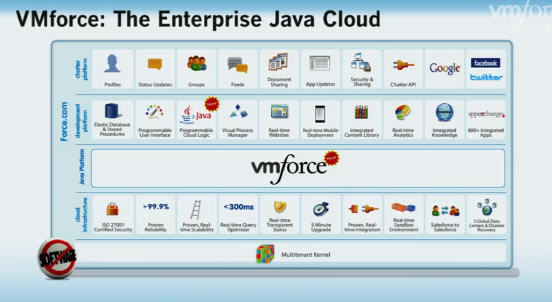Salesforce.com's partnership with VMware: Offense, defense or something in between?

Salesforce.com CEO Marc Benioff and VMware chief Paul Maritz took the stage in San Francisco Tuesday to unveil VMforce, a partnership that will bring Java to the Force.com platform. The implication is that more enterprise apps---there are a lot more enterprise Java developers than Salesforce.com Apex ones---will make it to the Force.com platform.
In between the "transformational," "sea of complexity," "enabling new ways of business" and "Facebook imperative" comments rests the big question: Is the Salesforce.com move about offense, defense or something in between?
If the Salesforce.com Java integration pitch (statement, Sam Diaz coverage, Techmeme) sounds vaguely familiar that's because Amazon Web Services and Microsoft's Azure, which is primarily for .Net developers but has some early hooks in for other languages, already play---or plan to play--- nice with Java. These comparisons aren't an exact fit---Amazon is more of an infrastructure play and Microsoft is just getting rolling---but the message is clear: You need to play with Java and Salesforce.com couldn't stick with its proprietary Apex programming language.
In a nutshell, Salesforce.com is partnering with VMware for its SpringSource Java platform. VMware is aiming to be the arms dealer to cloud providers with its SpringSource development framework and vCloud operating system. From there, VMforce will allow Java developers to plug into Force.com services such as Chatter, search, CRM and other tools. The demo Tuesday made the move from Force.com to SpringSource look easy with standard APIs. Toss in Chatter and the demo was instructive.
In theory all of these parts will plug together seamlessly to build "next-generation enterprise Cloud 2 apps that are instantly social, mobile, and collaborative."
That's a mouthful that looks just swell in a graphic.
You can argue that Salesforce.com's partnership with VMware is more about defense than offense. Amazon and Microsoft are building out massive infrastructure as a service plays. Google is doing the platform as a service pitch. Salesforce.com couldn't be left on an island with its Apex-driven Force.com platform. As Vinnie Mirchandani noted, early adopters are going 100 percent into cloud computing. The rest of the enterprise world isn't so quick. But Mirchandani added that you can't get to 100 percent cloud without a lot of custom development. Frankly, you can't have that custom development without Java enterprise applications.
Mirchandani---sitting next to me at the VMforce powwow---characterized Salesforce.com's move as an offensive approach. But Bob Warfield cuts to the chase in a blog post:
There is a lot to like about Force.com and a fair amount to dislike. Let’s start with Force.com’s proprietary not-quite-Java language. Suppose we could dump that language and write vanilla Java? Much better, and this is exactly what VMForce offers.
Let's get real. There's a race to be your infrastructure-platform-software as a service provider and developers will play a big role in deciding who wins. The leader could be Google, Microsoft, Amazon Web Services, which has a bunch of enterprise software partnerships, IBM, Rackspace and others. Salesforce.com has to get into that conversation to be a dominant platform as a service provider.
Add it up and the VMforce play makes a lot of sense. Salesforce.com needed to open up. VMware gets a high profile partnership for SpringSource as well as its vSphere cloud operating system. It's about the developers.
"Java is the No. 1 developer language in the enterprise. Enterprise developers don't have a clear path to the cloud," said Benioff. VMforce aims to fill that gap. Force.com developers can now use Java.
What about the offense? Whether Salesforce.com's VMforce move is offensive largely depends on what happens going forward. It's very early in the platform-as-a-service effort. Can Salesforce.com embed Chatter into a lot of legacy applications? Will the enterprise be more likely to attach Salesforce.com's CRM and other apps to their core legacy systems? What does the integration picture look like?
Force.com's history as a developer platform and the drag-and-drop ease of use could be a winner in the long run. If that scenario plays out VMForce is a offensive move that could be a game changer.
Salesforce.com's Anshu Sharma makes the case that VMforce is a big deal and about playing offense.
Java developers today have no clear path to building next-generation cloud applications. They can build on-premise applications and deploy them on legacy stacks, but installing and integrating the different pieces you need to build a truly useful application can be a nightmare. Or, they can take the same jumbled stack and run it in a hosted environment – renting servers by the hour or by the month. While Infrastructure as a Service offerings have some benefits if you want to test an application or need spike capacity, they still require the developer and the systems administrators to do a lot of heavy lifting – it's like renting an empty apartment where water, electricity and garbage are provided but you must bring all the appliances, hook them up yourself, and make all the repairs. What you really want is a fully furnished apartment that you can customize to meet your needs and not be responsible for every minor upgrade or fix.
OK, but there are a lot of folks trying to sell fully furnished apartments for technology executives and developers. It's clear as day that Amazon, which is adding capacity for its infrastructure services, Microsoft and Google will invest billions pursuing the next-gen enterprise. How much will Salesforce.com and VMware invest? Will developers decide the day?
Simply put, the proof will be in the enterprise implementations going forward.
Related:
Paul Greenberg: Salesforce Enters the REAL Cloud -- I Think
FinancialForce puts some meat on Salesforce.com's Chatter effort
